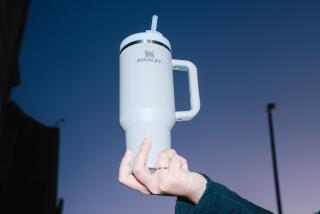It’s hip, it’s happening: Would you believe it’s Pabst?
- Share via
America has discovered a new beer, one that seems right for a country facing bad times.
Pabst Blue Ribbon, a forgotten if not forsaken brand, once the solace of the working man and, regrettably, a beer often associated with what people in polite company call “trash,” has staged a surprising comeback. The resurgence is mostly among young adults, led by snowboarders and indie filmmakers.
Perhaps it’s a sign of the times, or a remembrance of the way it was, or a toast to blue-collar virtue. However you pour it, Pabst is America’s new beer for a simple reason: It is not new at all.
Melissa Brown, a 28-year-old New York artist, recently served Pabst at the opening of her art show at the Bellwether Gallery in the fashionable and hip Brooklyn neighborhood of Williamsburg. She explains her choice by saying, “It’s time to get back to the basics.” The owner of the gallery says requests for Pabst Blue Ribbon have become so common it’s now “the official gallery beer.”
At Whitey’s in Arlington, Va., suited-up young Republicans, faux cowboys and dead-serious blue-collar drinkers line up faithfully for a weekly Pabst special.
In Park City, Utah, a group of professional and semi-professional snowboarders has discovered Pabst. For the last few years, they’ve congregated on Super Bowl Sunday and played tackle football in Pabst hats and jackets. They call it the Pabst Bowl.
Nationwide, grocery store sales of Pabst Blue Ribbon climbed 12% in the 52-week period ending in late November. Total sales have increased 5% from the last year. “For us, that’s a really big deal,” says Pabst brand manager Neal Stewart. “That’s one of the best increases we’ve had since 1978.”
The increase comes the way a populist trend should: from the ground up. Pabst is a blend of economy (in bars, it goes for no more than $2.50 a can or bottle) and Americana, without the heavy marketing campaigns. It represents simpler times in a world of corporate scandals, 24-hour news, terrorism and burst economies.
When asked about Pabst sales, Benj Steinman, president of the industry journal Beer Marketer’s Insights, immediately uttered the buzzwords of pop-culture observers: “retro chic,” a phrase hung on a host of young adults who affect the style and attitude of the mythical good ol’ days: real or imagined working-class values clothed in polyester button-downs, Chuck Taylor shoes, Levis and old T-shirts.
Accordingly, Pabst sales have been concentrated mostly in areas popular among the throwback generation: the Pacific Northwest, New York and Midwestern urban centers such as St. Louis.
When sales started to increase among snowboarders, Pabst marketers did something almost unprecedented: They stayed out of the way.
“We want people to discover it,” Stewart says. “We allow them to find that it’s on the premises, that it’s making a comeback.”


